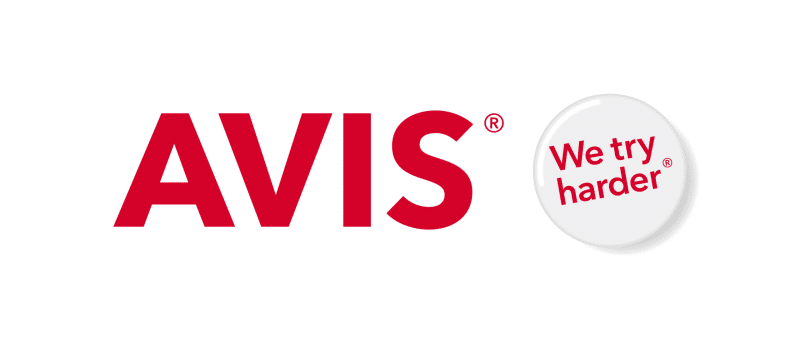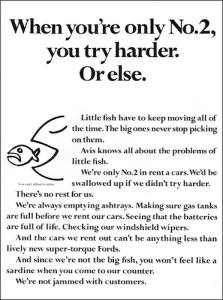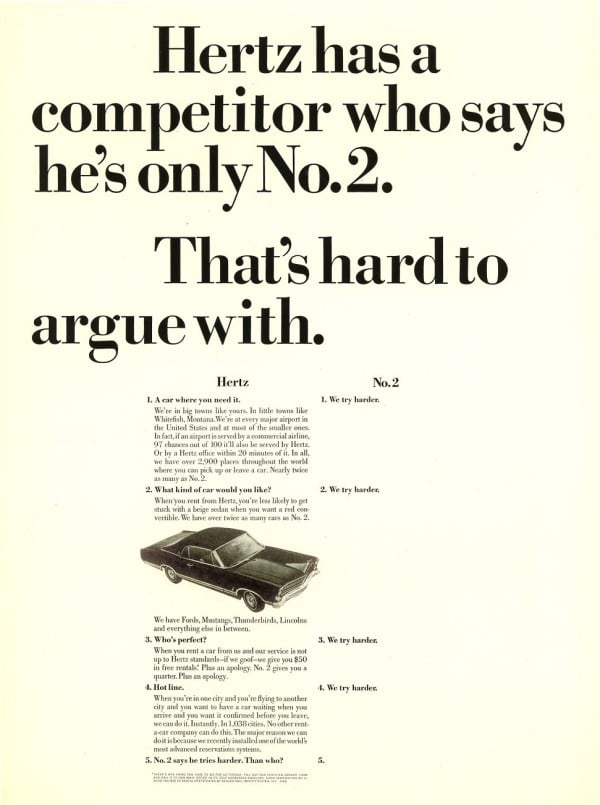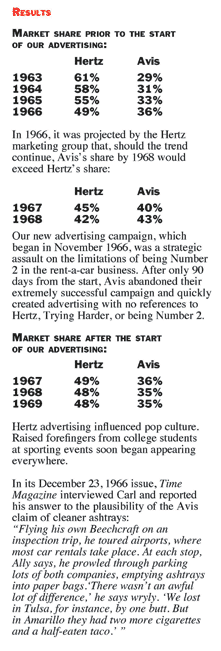
Ever wonder what happened to Avis’s “We’re No. 2” campaign?
 I always assumed Avis foolishly dropped it out of boredom. Some brand manager wanted to put his “mark” on things and foolishly killed the goose that was laying golden eggs.
I always assumed Avis foolishly dropped it out of boredom. Some brand manager wanted to put his “mark” on things and foolishly killed the goose that was laying golden eggs.
But that’s not nearly as interesting as what really happened…
See, a few years after Avis and Doyle Dane Bernbach launched their legendary campaign, Hertz got nervous about how quickly Avis was gobbling up their market share.
So Hertz got wise and hired the other legendary creative agency of the day: Ally & Gargano.
If you’re not familiar with Ally & Gargano, they created “When it absolutely, positively, has to be there overnight” for FedEx as well as “Time to make the donuts” for Dunkin Donuts, among many other brilliant campaigns.
And here’s the launch ad for the counter-campaign that Carl Ally created for Hertz:

The campaign basically takes Avis’s “We’re No. 2” position and rams it right up their arse, detailing point by point what customers give up when they rent cars from the also-ran competition:
- locations,
- car selection,
- guaranteed performance,
- customer support infrastructure, etc.
And you gotta love that ending line: “No. 2 says he tries harder. Than who?”
That counter-campaign went for the throat. And the results show that it worked:
To the right, you’ll see a snapshot from the book, Ally & Gargano, detailing the results from their Hertz campaign. The important points to note are:
- “After only 90 days from the start [of the campaign], Avis abandoned their extremely successful campaign and quickly created advertising with no references to Hertz, Trying Harder, or being Number 2.”
- From the launch of the campaign at the tail-end of 1966, Avis’s market share flat-lined and Hertz maintained their position as the leader in the industry (which wouldn’t have happened had the earlier trends continued on for another 2 years).
And that’s what happened to the famed “We’re Number 2” advertising campaign.
3 Critical Lessons
So what are the lessons to take away from this?
Don’t Wimp Out on a Campaign That’s Working
If an ad campaign is driving serious growth in market share, as Avis’s was, there’s no good reason to abandon it. In fact, you should double down on it instead.
If a competitor attacks the campaign, that’s just further proof that it’s working. Double down!
There is however, one bad reason to abandon such a campaign:
You can no longer make the reality match the advertising promise.
Before the Avis campaign was launched in 1963, Bill Bernbach insisted that Avis revamp their fleet and actually improve the customer experience so that he had a “better reality” to advertise.
In fact, every Avis employee had the next month’s ads included in their paychecks to ensure they understood what was being promised to the public.
[And I’d highly recommend you follow suit by playing your ads for your employees]
So why’d Avis stop the campaign?
I can only speculate, but I’d guess that by the third year after the fleet revamp, Avis was no longer “trying harder” in the way the ads promised. So when that started being publicly called out by Hertz, Avis killed the campaign.
What they should have done was re-commit to the reality, and then doubled down on the advertising.
You can’t afford to ignore great advertising.
If a competitor has launched an immensely successful ad campaign that resonates with the public and that’s driving increased market share, you must respond.
And the only way to effectively respond to that challenge is with great advertising of your own.
Note: please don’t launch a me-too copy of the competition’s campaign.
Hertz didn’t try to advertise that they “try even harder.” Instead, they advertised THEIR strengths. If Avis was going to position themselves as “Number 2,” Hertz would gladly acknowledge being “Number 1” and then establish WHY they’re the top dog.
So if a competitor’s advertising is generating fame and results for them, you need to find an advertising wizard who understands the ins and outs of comparative advertising.
Understand that counter-branding works both ways
Ries and Trout famously advised challenger brands to “find the weakness in your competitor’s strength” and that’s exactly what Avis did with their “No. 2” campaign. It’s a rightly-famous example of counter-branding.
But “Marketing is often a battle for legitimacy. And the first brand that captures that concept is often able to portray its competitors as illegitimate pretenders.”
That’s how Hertz countered Avis’s counter-branding — by re-framing Avis as an illegitimate pretender to the “customer service” throne.
So while there’s a lot to be said about staying positive with your advertising messaging, great advertising often embodies the power of thumos by clearing calling out what the brand stands against.
It might not feel positive — just as Hertz’s ad doesn’t feel positive — but it IS powerfully persuasive nonetheless.
And it pays to get an ad writer who understands that persuasive cheat-code on your team.
- Are You Paying for Too Much for the Wrong Keywords? - July 15, 2024
- Dominate Your Market Like Rolex — 4 Powerful Branding Lessons - July 3, 2024
- Military-Grade Persuasion for Your Branding - June 25, 2024
